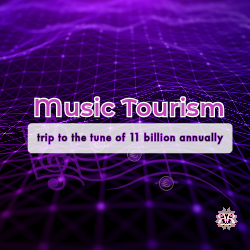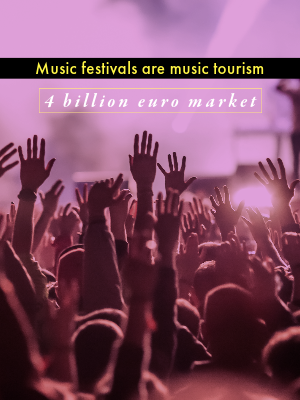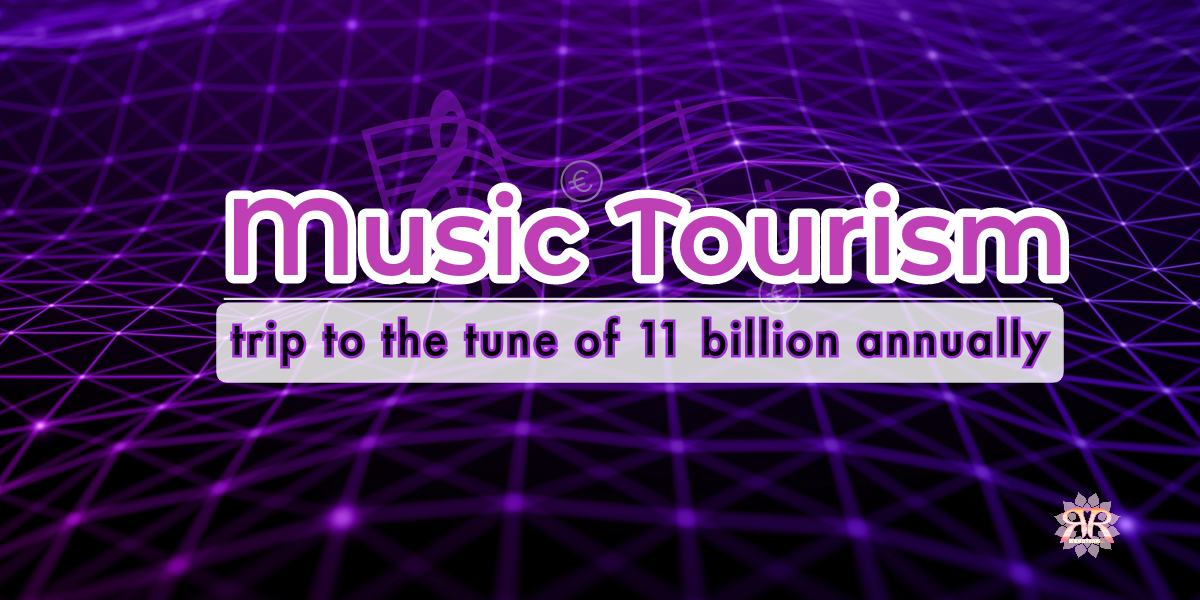Table of Contents

What is Music Tourism?
Music tourism involves travelling to a place to experience a live music event. A person, or group, may go solely for the event, or the music event may fit alongside other activities.
The importance of quantifying the value of music tourism cannot be overstated. Many people perceive music as an expense. If one stops and thinks about the cost of promoting cultural events, it sure can seem like a lot of money to spend. But, when one then calculates the ROI, what appeared to be an expense suddenly shows itself to be an investment.
The Value of Music Tourism
Future Market Insights predicts the music tourism market to grow to 14 billion USD annually by 2033. The value of the sector is currently estimated to be 11 billion USD.
Music tourism moves people – and money.
Live music is a “scarce” event. Supply and demand is the basis of capitalist economic theory. When there is scarcity, prices increase.. In real life, this means that people are willing to spend time and money on “once in a lifetime trips” to see and hear their favourite musicians play live.
The recent Taylor Swift “Eras” tour is a case in point. Swift made so much money from her tour that she could pay a 100,000 USD bonus to each of her truckers.
If you live in one of the 20 locales Swift, 33, performed at in the last five months, your city has likely seen a boost in revenue from the hundreds of thousands of attendees who traveled from near and far.
https://time.com/6307420/taylor-swift-eras-tour-money-economy/
Another case in point is Madonna’s “Celebration” tour, her latest jaunt around the globe, which Billboard estimates may generate upwards of 100 million USD. Pop stars of this caliber draw people from a huge radius. These fans fork out not only for tickets, but for food, accommodation, transportation, and souvenirs.
Classical music is also an enormous attraction. In countries like Italy or Germany, aficionados will spend significant sums for a seat. La Scala in Milan is known for its atmosphere and the exceptional quality of its performances. It is a must-visit destination for classical music tourists. But, to enjoy an opera at La Scala, fans must spend €165-210 for a single ticket.
Who’s Who in Music Tourism?
There are increasing numbers of projects dedicated to promoting destinations to music fans. Here is a small selection.
Music and Tourism: On The Road Again
Published in 2005 by Chris Gibson (Australia), this scholarly book is considered to be the first one about music and tourism. Describing music tourism as a “niche”, which it is, the authors look at the phenomenon from various viewpoints. Historical and contemporary analyses, financial and cultural, plus the politics of copying and identity. This looks like one that I ought to get my hands on.
Sound Diplomacy
This consultancy works with the economics of culture, music, leisure, hospitality, policy, planning, and placemaking.
Shain Shapiro is the main person here. He has just published his second book, “This Must Be The Place.”
Music Cities Events
Music Cities Events is a platform that aims to educate on the value of music. They organize events all around the globe. These conferences showcase music tourism, music policy and, of course, music cities.
TIIM – Turismo Amplificado
The Valencian government has created an initiative to promote music tourism. I will be in attendance at the Jornadas TIIM on 13 & 14 December 2023, in Valencia. Will you be there? Let’s connect!
Estaré en la Jornadas TIIM en Valencia el próximo 13 y 14 de diciembre. ¡Me encantaría conectar contigo!
Music “pilgrimages” to specific cities.
Places like New Orleans, Nashville, Seville, or Berlin are magnets for music lovers. Trips to these emblematic places are akin to pilgrimages; such is the passion that music arouses.
Each city has its allure for music enthusiasts, whether it resonates with the smooth sounds of jazz, the vibrant energy of rock and roll, the passionate rhythms of flamenco, or the pulsating beats of techno.
Carnival!
Famous street parties are found worldwide and most are raucous celebrations of music, dance, and color. Rio de Janeiro, in Brazil, has its famous samba parades. The Notting Hill Gate Carnival in London features soca and reggae music. The Cádiz “Carnavales”, in Southern Spain, features flamenco singing and dancing.
Music Festivals
These exemplify a form of music tourism. Music festivals abound in the summer months in both the northern and the southern hemispheres. Festivals can last from one day to over a week. Longer festivals require, logically, a bigger investment of both time and money. Whether festival goers are camping on-site or staying off-site, they will need to pay for travel, accommodation, food, and tickets. In Spain, the average person spends 300€ per festival, according to TIIM.

Holiday Entertainment
We have all been there: on holiday, in an unfamiliar place, and hungry or thirsty. How do we choose where to sit down? Google Maps or TripAdvisor can help, but even with these aids, we will use our specific criteria to choose. The music filtering (or blaring, depending on your taste) will determine to a large degree whether you sit down or walk on by.
Some people may save all year for their holiday, and they want to savor every moment of their much-deserved break. Investing in some form of musical entertainment is crucial for bar and restaurant owners as it greatly enhances the overall guest experience.
By the way, if you ever visit Benidorm, I DJ at the Caiman Beach Bar and the D-Vora Sky Bar. So make sure to come and say hello.
Finale
As I study Neuromusic more, I become increasingly fascinated by the connection between music and our daily lives. Music tourism matters – it moves people and it moves money.
After my visit to TIIM, I will give you an update. Watch this space. Meanwhile, keep on moving, don’t stop, no.

